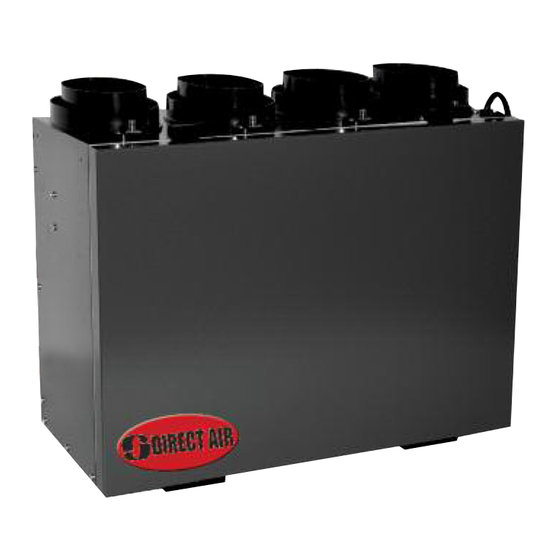Direct Air PHRV Handbuch für Installation, Betrieb und Wartung - Seite 12
Blättern Sie online oder laden Sie pdf Handbuch für Installation, Betrieb und Wartung für Belüftung Direct Air PHRV herunter. Direct Air PHRV 16 Seiten. Heat recovery ventilator

OPERATION
A Heat Recovery Ventilator (HRV) is designed to bring fresh air into a building while exhausting an equal amount of stale air. During the winter
months, the incoming cold fresh air is warmed by utilizing the heat recovered from the stale air before it is exhausted to the outdoors. During sum-
mer months when the indoor space is air conditioned, the HRV will help in cooling the incoming fresh air with the stale air that is being exhausted.
Powrmatic HRV's are designed to run continuous or on intermittent, giving the homeowner complete control over their air quality. Continuous
low speed ventilation is recommended, which will help eliminate carbon dioxide, voc's and other gases as well as freshen up the home.
Intermittent high speed ventilation can be obtained through a variety of optional remote controls found in this manual. Below are some examples
of seasonal operation of an HRV.
Winter:
Humidity control is very important during the winter
months. This is when problems will be most apparent
since condensation on the windows will often occur. The
colder the outside temperature, the greater the risk of
condensation in the home. The average relative humidity
should be maintained between (30-60) to avoid conden-
sation. Low speed continuous ventilation with high speed override is rec-
ommended.
Summer:
The air is sometimes hot and humid. To stop the warm
humid air from entering, set the dehumidistat at its
highest level. If the Intellitek series controller is
installed, the air exchanger can be set to cycle the unit
on and off as desired from that wall control. However,
continuous ventilation is recommended.
MODES OF OPERATION
The entire line of PHRV & PHRVR series Heat Recovery Ventilators comes equipped with Powrmatic's new electronic uni-control board which offers
a wide variety of features making it the ultimate ventilation control system. Powrmatic engineers have used the latest technology to provide solid,
trouble free operation under any conditions.
The Powrmatic uni-control board offers stand alone operating capabilities as well as an exclusive 2 wire communication to most external controls.
The trouble-free optional controls include: two different rotary dial dehumidistats, an air quality sensor (3 wire communication required), a 15 minute
remote push-button timer, as well as the most sophisticated line of remote wall mounted controls, the Intellitek 5MR.
An on-board diagnostic LED helps find problems quickly and efficiently. For example the LED can be used to signal a broken or shorted electronic
wall control wire. Electronic air temperature probe gives this board accurate readings in order to minimize unnecessary defrost operation, and the
on-board jumpers provide the user with the option of adjusting defrost time and sequence to optimize performance under abnormal conditions. The
defrost operation
is automatic and is usually never adjusted.
Air from
Outside
Air to
Outside
air at the rate you select, either at low or medium speed, and switches
to high speed when activated by an optional remote control. The "Low"
and "Med" fan speed selection will cause the unit to operate in continuous
exchange mode at an exchange rate of 35% and 50% maximum airflow
rating respectively. Continuous mode is recommended, since pollutants
are slowly but constantly being generated in your house.
12
1. Continuous / Ventilation Mode
Air from
House
In this mode of operation both fans
are operating and exchanging air with
the outside. The heat recovery venti-
Air to
House
lator (HRV) constantly exchanges the
Spring:
Temperatures are more moderate and become
warmer each day. To keep the humidity and tem-
perature uniform, set the dehumidistat higher (if
installed). You may also switch the HRV to standby
mode if desired.
Fall:
Rain and rapid temperature changes make it diffi-
cult to control the internal humidity level and may
result in condensation on the windows. A remote
dehumidistat may help give greater control over the
inside environment.
Air from
House
Air to
outside
shuts down and the exhaust motor goes into high speed. Ambient air
is passed through the unit for a period of 5 minutes. The supply
motor will then re-start and run at the preset speed. The exhaust
motor will also slow down to the preset speed, and the unit will oper-
ate in the run cycle for 25 minutes. This fan shutdown defrost cycle
continues until the supply air stream rises above 0°C (32°F).
2. Defrost (PHRV Models)
The automatic defrost cycle PHRV
models of HRVs consists of a fan
shutdown. When the supply air
stream temperature goes below -
5°C (23°F), the supply motor
12
